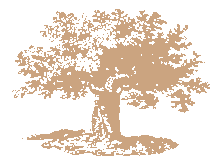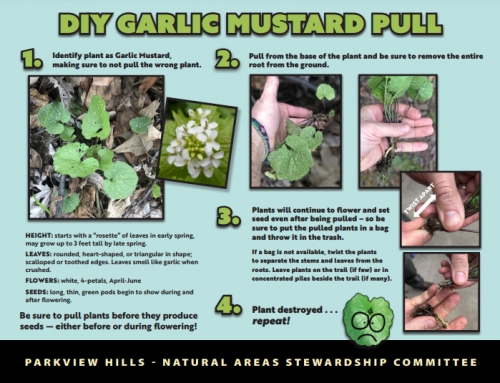On Saturday, November 16, volunteers coordinated by the Natural Areas Stewardship Committee removed one of Michigan’s Top 20 invasive species, Honeysuckle, along 600 feet of the trail south of the Clubhouse parking lot to the juncture of the Willow Lake Circle trail. Late fall and winter are the optimal times to remove some invasives like Honeysuckle. In this case, Honeysuckle was cut, stumps were treated with herbicide to prevent re-sprouts, and the cut stems were stacked along the trail. A wintery warm thanks to John Esch and Stan Rajnak (Oaks), Laurie Young (Shores), Hilary Hunt (Meadows), Caren Braymer and Mike Kruk (Pines), Rochelle Habeck and Allan Hunt (Cliffs), and Vaughn Maatman (Old Field Place).
This was the first volunteer opportunity in a long-term effort to remove Honeysuckle from our common natural areas along Parkview’s trails. Honeysuckle is one of several imported landscaping plants from East Asia and Japan throwing off the balance of plants and animals in Parkview’s natural areas. Spread by berries and seeds, it forms dense stands of 6-16 foot shrubs, crowding out native plants and reducing food and reproduction resources for songbirds, butterflies, and other insects. Unlike Michigan’s native plants, which evolved with Michigan’s native insects, birds, and animals, Honeysuckle’s foliage is unpalatable to most native insects. Because native songbirds rely on native insects to feed their young, birds raise their broods elsewhere, thereby reducing the population of our native songbirds and pollinators along with native plants in areas where Honeysuckle thrives.
Honeysuckle was first planted in landscaping at Parkview Hills. As with many invasives, Honeysuckle’s berries and seeds were spread by wind, birds, and animals beyond its landscaping boundaries. Landscaping plants like Honeysuckle change the balance and numbers of both plants and animal species in natural areas, thereby changing the ecology. The Natural Areas Stewardship Committee will lead efforts to protect our native plants, songbirds, and animals in Parkview’s natural areas by removing invasives and encouraging the propagation of native species.
Trail hikers will notice piles of cut Honeysuckle along the trail for a period of time. The cut Honeysuckle will be chipped at a later date, and the chips will be spread on the trail surface, turning an invasive into a resource. Restoring a natural area like ours requires us to think in ecological time. The Natural Areas Stewardship Committee has embarked on a generation-long plan. Six hundred feet behind us, another mile or two to go before the job is done. Join us for the long haul by volunteering to remove invasives, work on the trails, and plant native species as we restore the “native” to our natural areas.


